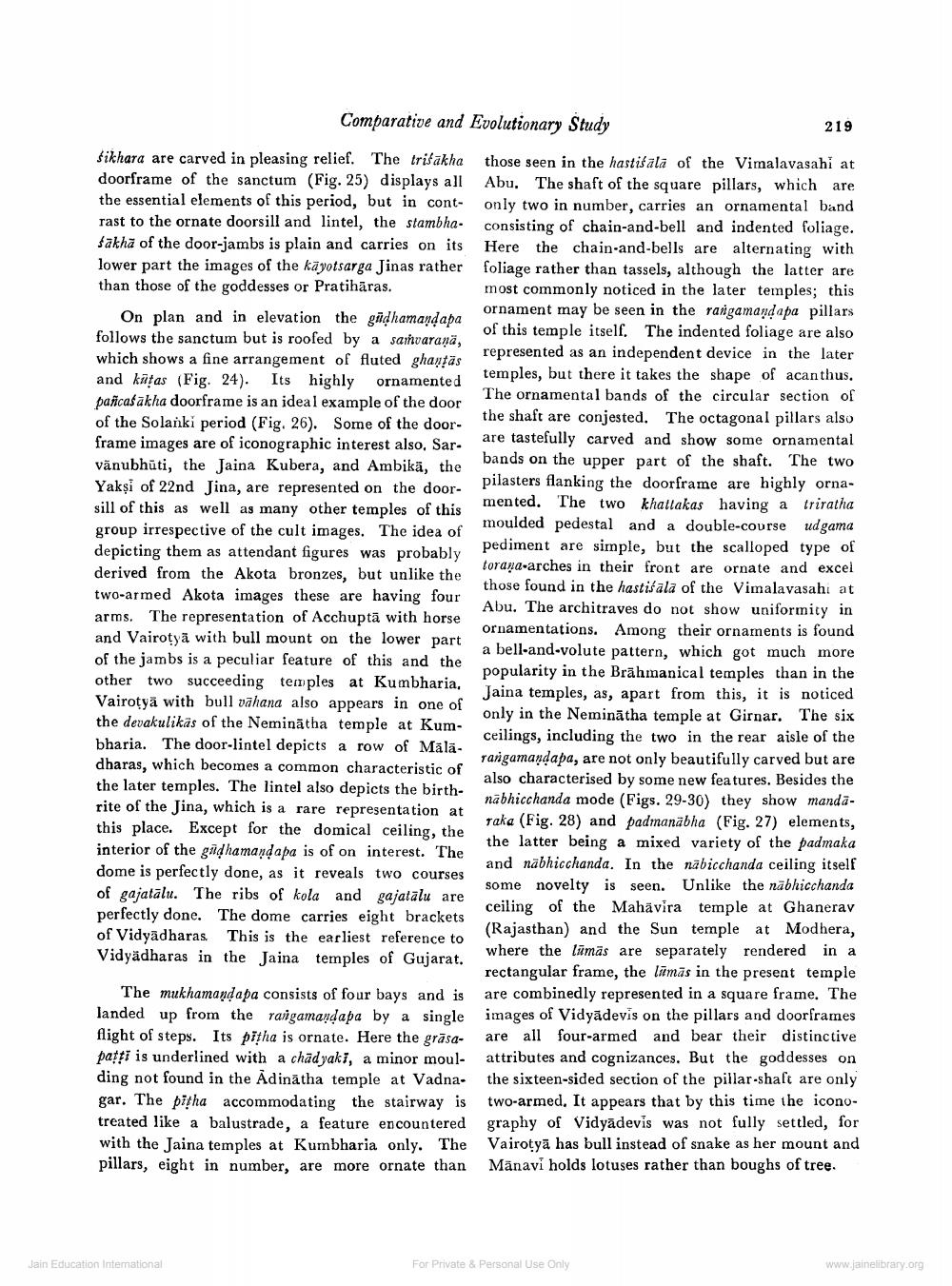________________
Comparative and Evolutionary Study
219
śikhara are carved in pleasing relief. The trifakha those seen in the hastišala of the Vimalavasahi at doorframe of the sanctum (Fig. 25) displays all Abu. The shaft of the square pillars, which are the essential elements of this period, but in cont only two in number, carries an ornamental band rast to the ornate doorsill and lintel, the stambha. consisting of chain-and-bell and indented foliage. fakhā of the door-jambs is plain and carries on its Here the chain-and-bells are alternating with lower part the images of the kāyotsarga Jinas rather foliage rather than tassels, although the latter are than those of the goddesses or Pratihāras.
most commonly noticed in the later temples; this
ornament may be seen in the rangamandapa pillars On plan and in elevation the gädhamandapa
of this temple itsell. follows the sanctum but is roofed by a samvarana,
The indented foliage are also
represented as an independent device in the later which shows a fine arrangement of fluted ghantäs and kūtas (Fig. 24). Its highly ornamented
temples, but there it takes the shape of acanthus.
The ornamental bands of the circular section of pañcasākha doorframe is an ideal example of the door of the Solanki period (Fig. 26). Some of the door
the shaft are conjested. The octagonal pillars also frame images are of iconographic interest also, Sar
are tastefully carved and show some ornamental vānubhūti, the Jaina Kubera, and Ambikä, the
bands on the upper part of the shaft. The two Yakși of 22nd Jina, are represented on the door
pilasters flanking the door frame are highly ornasill of this as well as many other temples of this
mented. The two khattakas having a triratha
moulded pedestal and a double-course ud gama group irrespective of the cult images. The idea of
pediment are simple, but the scalloped type of depicting them as attendant figures was probably derived from the Akota bronzes, but unlike the
torawa-arches in their front are ornate and excel
those found in the hastišala of the Vimalavasahi at two-armed Akota images these are having four
Abu. The architraves do not show uniformity in arms. The representation of Acchupta with horse
ornamentations. Among their ornaments is found and Vairotyä with bull mount on the lower part
a bell-and-volute pattern, which got much more of the jambs is a peculiar feature of this and the
popularity in the Brāhmanical temples than in the other two succeeding temples at Kumbharia,
Jaina temples, as, apart from this, it is noticed Vairotyä with bull vāhana also appears in one of
only in the Neminātha temple at Girnar. The six the devakulikäs of the Neminātha temple at Kumbharia. The door-lintel depicts a row of Mālā.
ceilings, including the two in the rear aisle of the dbaras, which becomes a common characteristic of
rargamandapa, are not only beautifully carved but are the later temples. The lintel also depicts the birth
also characterised by some new features. Besides the rite of the Jina, which is a rare representation at
nābhicchanda mode (Figs. 29-30) they show mandathis place. Except for the domical ceiling, the
Taka (Fig. 28) and padmanabha (Fig. 27) elements,
the latter being a mixed variety of the padmaka interior of the gadhamandapa is of on interest. The dome is perfectly done, as it reveals two courses
and nābhicchanda. In the nabicchanda ceiling itself
some novelty is seen. Unlike the näbhicchanda of gajatālu. The ribs of kola and gajalalu are perfectly done. The dome carries eight brackets
ceiling of the Mahāvira temple at Ghanerav of Vidyādharas. This is the earliest reference to
(Rajasthan) and the Sun temple at Modhera, Vidyadharas in the Jaina temples of Gujarat.
where the lūmās are separately rendered in a
rectangular frame, the limās in the present temple The mukhamandapa consists of four bays and is are combinedly represented in a square frame. The landed up from the raigamandapa by a single images of Vidyādevis on the pillars and doorframes flight of steps. Its pitha is ornate. Here the grāsa are all four-armed and bear their distinctive patti is underlined with a chadyaki, a minor moul- attributes and cognizances. But the goddesses on ding not found in the Adinātha temple at Vadna. the sixteen-sided section of the pillar-shaft are only gar. The pitha accommodating the stairway is two-armed. It appears that by this time the iconotreated like a balustrade. a feature encountered graphy of Vidyādevis was not fully settled, for with the Jaina temples at Kumbharia only. The Vairotyā has bull instead of snake as her mount and pillars, eight in number, are more ornate than Mānavi holds lotuses rather than boughs of tree.
Jain Education International
For Private & Personal use only
www.jainelibrary.org




